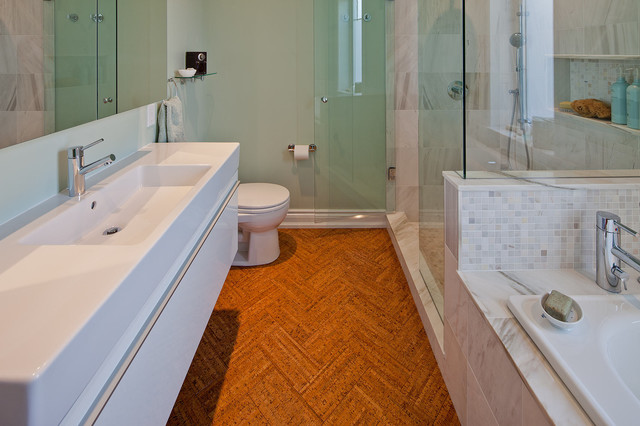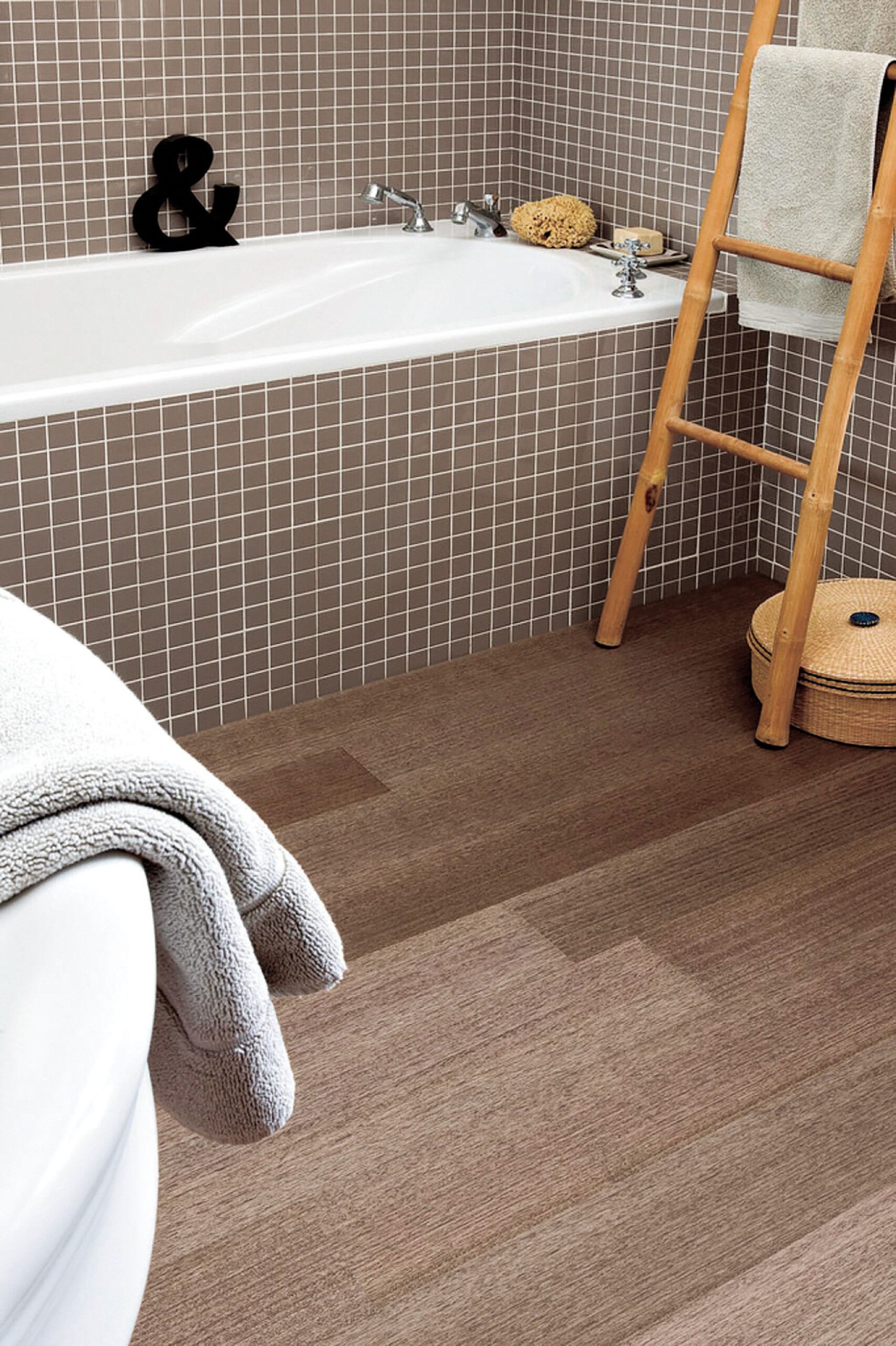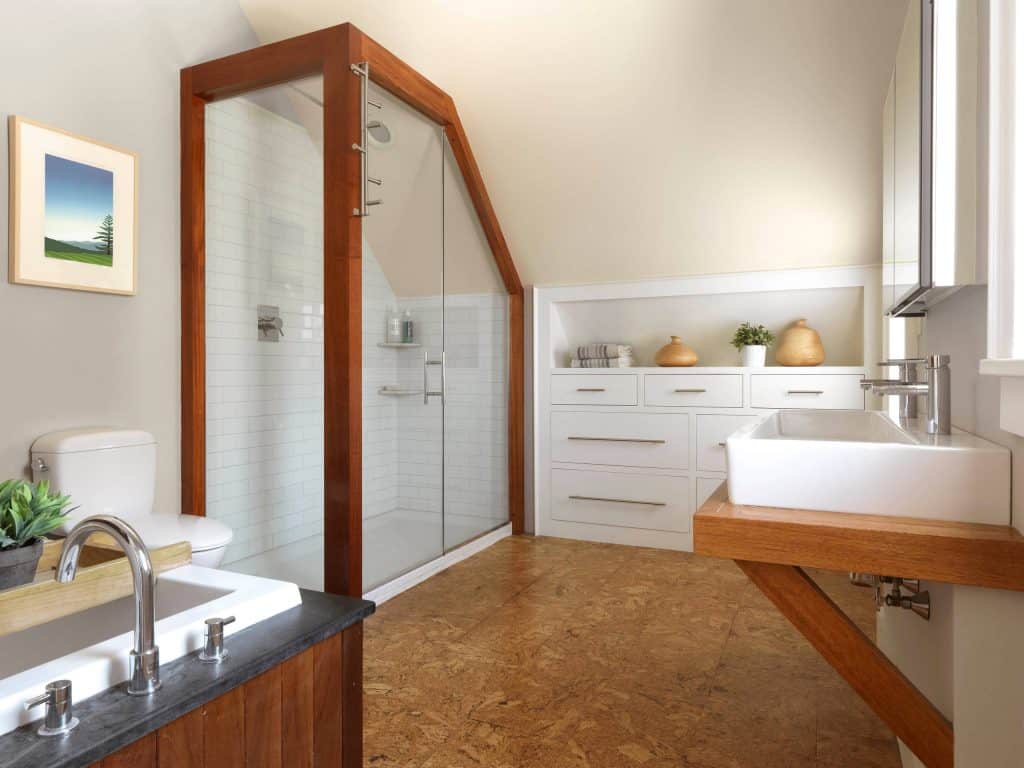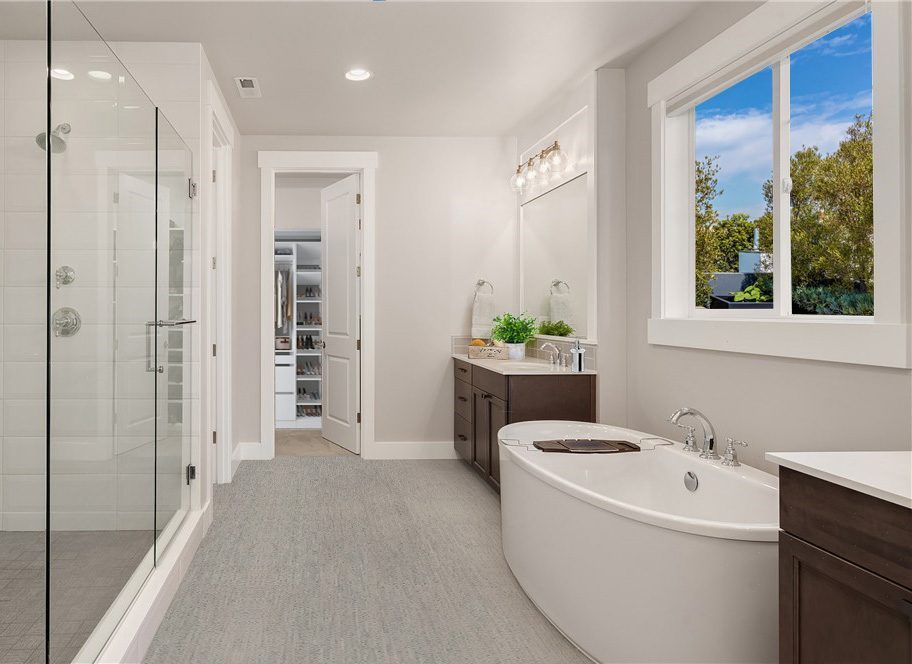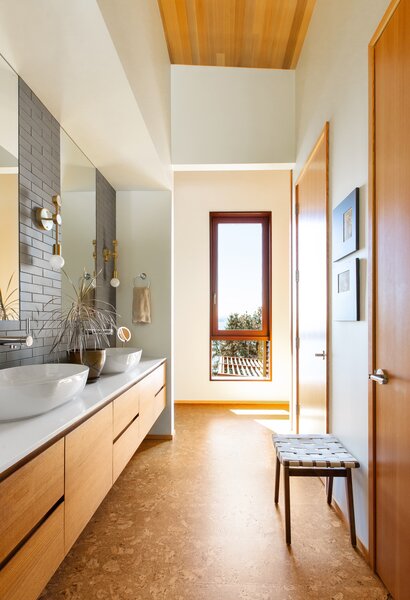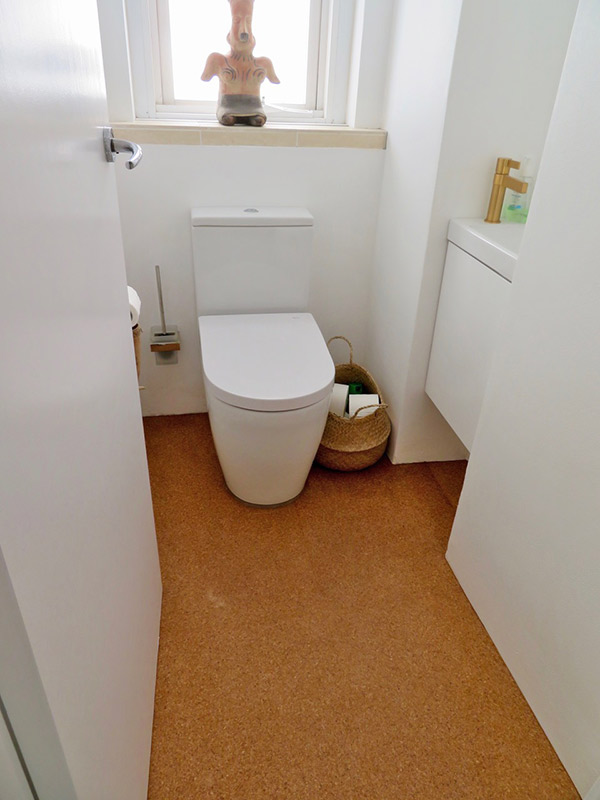Introduction to Cork Flooring: Exploring the Eco-Friendly and Versatile Option
Cork flooring has gained significant popularity in recent years as a sustainable and versatile choice for various spaces in the home, including the bathroom. This unique material is harvested from the bark of cork oak trees, making it an eco-friendly option compared to traditional flooring materials. Today we will discuss more about cork flooring, exploring its benefits, design options, installation tips, and environmental impact.
- Eco-Friendly Material: Cork flooring is renowned for its sustainability. Harvesting cork does not harm the tree, as only the bark is removed, and the tree continues to grow, producing more cork. Additionally, cork forests are vital ecosystems that support biodiversity and combat desertification. Choosing cork flooring for your bathroom contributes to the preservation of these valuable ecosystems.
- Natural Insulation: One of the remarkable properties of cork is its natural insulation. In the bathroom, where cold floors can be uncomfortable, cork provides warmth and comfort underfoot. Its cellular structure contains millions of air-filled chambers that act as natural thermal insulators, helping to maintain a comfortable temperature in your bathroom year-round.
- Resilience and Comfort: Cork flooring offers a cushioned surface that is gentle on the feet, making it ideal for bathrooms where comfort is a priority. Its resilience allows it to bounce back from pressure, providing a soft and supportive surface for walking and standing. This resilience also makes cork flooring resistant to dents and impacts, ensuring its longevity in high-traffic areas like the bathroom.
- Water Resistance: Contrary to common misconceptions, cork flooring is naturally resistant to water damage. The cellular structure of cork contains a waxy substance called suberin, which repels moisture and inhibits the growth of mold and mildew. Additionally, cork can be sealed with water-resistant finishes for added protection, making it a practical choice for bathrooms where moisture is prevalent.
- Acoustic Properties: Another advantage of cork flooring is its acoustic insulation properties. It absorbs sound, reducing noise transmission between floors and creating a quieter, more peaceful bathroom environment. This feature is especially beneficial in multi-story homes or apartments where soundproofing is desirable.
- Hypoallergenic and Easy to Clean: Cork flooring is inherently hypoallergenic, as it does not trap dust, pet dander, or other allergens like carpeting does. Its smooth surface is easy to clean with a damp mop and mild detergent, making maintenance a breeze in the bathroom. With proper care, cork flooring can retain its beauty and functionality for many years, enhancing the overall appeal of your bathroom space.

Benefits of Cork Flooring in the Bathroom
Cork flooring has emerged as a popular choice for bathroom design, offering a myriad of benefits that cater to both aesthetic preferences and practical considerations. Below are the advantages of cork flooring in the bathroom, focusing on comfort, durability, and water resistance.
Comfort Underfoot: One of the primary benefits of cork flooring in the bathroom is its exceptional comfort underfoot. Unlike cold and hard surfaces like tile or stone, cork provides a soft and cushioned feel, making it a delight to walk on barefoot, especially during chilly mornings. Its natural elasticity and resilience relieve pressure on the joints, offering a more comfortable experience for users of all ages.
Durability and Longevity: Despite its soft and yielding texture, cork flooring is surprisingly durable and resilient, capable of withstanding the rigors of daily use in the bathroom. The cellular structure of the cork enables it to recover from compression, ensuring that it retains its shape and integrity over time. Additionally, the cork’s natural resistance to abrasions and impacts makes it highly durable, reducing the need for frequent replacement and maintenance.
Water Resistance: One of the most significant advantages of cork flooring in the bathroom is its inherent water resistance. Thanks to the natural presence of suberin—a waxy substance that repels moisture—cork is well-suited to withstand the humid and wet conditions typically found in bathrooms. Properly sealed cork flooring forms a protective barrier against water infiltration, minimizing the risk of warping, swelling, or mold growth.
Warmth and Insulation: Cork flooring acts as a natural insulator, helping to maintain a comfortable temperature in the bathroom throughout the year. Unlike cold materials like ceramic or porcelain tile, cork retains heat and provides a cozy surface for bare feet, enhancing the overall comfort of the space. This thermal insulation also contributes to energy efficiency by reducing heat loss through the floor, resulting in potential cost savings on heating bills.
Noise Reduction: Another notable benefit of cork flooring in the bathroom is its ability to absorb sound and minimize noise transmission. This acoustic insulation creates a quieter and more peaceful environment, ideal for unwinding during a relaxing bath or shower. Whether you live in a bustling household or a multi-unit building, cork flooring helps to dampen footsteps, toilet flushes, and other sounds, fostering a tranquil atmosphere in the bathroom.
Easy Maintenance: Cork flooring is relatively low-maintenance compared to other flooring options, making it an attractive choice for busy homeowners. Regular sweeping or vacuuming, coupled with occasional damp mopping using a mild detergent, is usually sufficient to keep cork floors clean and pristine. Unlike grouted tile or hardwood, cork’s smooth surface minimizes dirt and dust accumulation, simplifying the cleaning process and reducing allergen exposure in the bathroom.
Design and Style Options
When it comes to designing a bathroom space, aesthetics play a crucial role in creating a welcoming and visually appealing environment. Cork flooring offers a wide range of design and style options that allow homeowners to enhance the beauty of their bathrooms while ensuring functionality and durability. Below are various design possibilities with cork flooring, from colors and patterns to textures and finishes.
Natural Beauty of Cork: One of the most appealing aspects of cork flooring is its natural beauty and warmth. Available in a spectrum of earthy tones, ranging from light beige to rich chestnut, cork adds a touch of organic elegance to any bathroom setting. The unique grain patterns and textures inherent in cork create visual interest and depth, enhancing the overall aesthetic appeal of the space.
Color Choices: Cork flooring comes in a diverse array of colors to suit different design preferences and themes. Whether you prefer the timeless charm of natural cork with its warm honey hues or opt for contemporary shades like gray or charcoal, there’s a color option to complement every style and décor scheme. Lighter hues can make small bathrooms appear more spacious and airy, while darker tones add depth and sophistication to larger spaces.
Pattern and Layout Options: In addition to solid colors, cork flooring can also be found in various patterns and layouts, allowing for creative customization and personalization. From classic plank or tile patterns to intricate mosaic designs, the versatility of cork enables homeowners to achieve their desired aesthetic effect. Mix and match different cork tiles or planks to create visually dynamic floors that reflect your unique style and personality.
Texture and Finish Varieties: Cork flooring is available in a range of textures and finishes, each offering distinct visual and tactile characteristics. Opt for a smooth and sleek finish for a modern and minimalist look, or choose a textured surface for added depth and dimension. Matte finishes provide a subtle sheen and natural appearance, while glossy finishes offer a reflective quality that brightens up the space.
Integration with Other Materials: Cork flooring seamlessly integrates with other materials commonly used in bathroom design, such as tile, stone, wood, and metal. Create striking contrasts by pairing cork flooring with sleek marble countertops or stainless steel fixtures, or achieve a harmonious blend with coordinating tile accents or wood cabinetry. The versatility of cork allows for endless design possibilities, enabling you to customize your bathroom to suit your personal taste and style preferences.
Environmentally Friendly Design: Beyond its aesthetic appeal, cork flooring offers the added benefit of environmental sustainability, making it a conscientious choice for eco-conscious homeowners. By opting for cork flooring in the bathroom, you’re not only enhancing the beauty of your space but also reducing your carbon footprint and supporting responsible forestry practices.
Installation and Maintenance Tips
Installing cork flooring in the bathroom requires careful planning and attention to detail to ensure a successful outcome. From preparation and installation to ongoing maintenance, there are several key considerations to keep in mind to maximize the longevity and performance of your cork flooring. Below are essential installation and maintenance tips for achieving a beautiful and functional bathroom flooring solution with cork.
Pre-Installation Preparation: Before installing cork flooring in the bathroom, it’s essential to properly prepare the subfloor to ensure a smooth and level surface. Remove any existing flooring material, such as tile or vinyl, and thoroughly clean the subfloor to remove dirt, debris, and adhesive residues. Ensure that the subfloor is dry, flat, and free of any cracks or imperfections that could affect the integrity of the cork flooring.
Moisture Barrier Installation: Since bathrooms are prone to moisture and humidity, it’s crucial to install a moisture barrier to protect the cork flooring from water damage. Apply a high-quality moisture barrier, such as a waterproof underlayment or adhesive, to the subfloor before laying the cork tiles or planks. This barrier will help prevent moisture from seeping into the cork and causing warping, swelling, or mold growth over time.
Proper Installation Techniques: When installing cork flooring in the bathroom, follow manufacturer guidelines and recommendations for proper installation techniques. Use a high-quality adhesive specifically designed for cork flooring to ensure secure and stable adhesion to the subfloor. Allow the adhesive to cure completely before walking on or using the bathroom to prevent shifting or displacement of the cork tiles or planks.
Sealing and Finishing: After installing cork flooring in the bathroom, apply a protective sealant or finish to enhance durability and water resistance. Choose a sealant specifically formulated for cork flooring and follow manufacturer instructions for application and drying times. Ensure that the entire surface of the cork flooring is properly sealed, including seams and edges, to create a watertight barrier that repels moisture and prevents damage.
Regular Maintenance Routine: To keep your cork flooring looking its best and maintain its longevity, establish a regular maintenance routine for cleaning and upkeep. Sweep or vacuum the floor regularly to remove dirt, dust, and debris that can scratch or dull the surface. Use a damp mop with a mild detergent to clean the cork flooring periodically, avoiding excessive water or harsh cleaning chemicals that can damage the finish.
Preventing Water Damage: While cork flooring is naturally resistant to water, it’s essential to take precautions to prevent water damage in the bathroom. Wipe up spills and splashes promptly, especially around sinks, tubs, and showers, to prevent moisture from seeping into the cork. Use bath mats or rugs in high-traffic areas to absorb excess water and protect the cork flooring from prolonged exposure to moisture.
Understanding Cork’s Contribution to Green Living in Bathroom Design
In today’s environmentally conscious world, sustainability has become a significant consideration in home design and renovation projects, including bathroom remodeling. Cork flooring offers a sustainable alternative to traditional flooring materials, making it an attractive choice for eco-conscious homeowners. Let’s discuss the environmental impact and sustainability of cork flooring, highlighting its contribution to green living in bathroom design.
Renewable Resource: One of the key sustainability attributes of cork flooring is its renewable nature. Cork is harvested from the bark of cork oak trees, which can be harvested every 9 to 12 years without harming the tree. Unlike hardwood flooring, which requires the entire tree to be cut down, cork harvesting is a sustainable practice that promotes the health and longevity of cork oak forests.
Carbon Sequestration: Cork oak trees play a crucial role in carbon sequestration, absorbing CO2 from the atmosphere and storing it in their bark. By choosing cork flooring for the bathroom, homeowners can indirectly support carbon sequestration efforts and mitigate the impacts of climate change. Cork forests act as valuable carbon sinks, helping to reduce greenhouse gas emissions and combat global warming.
Minimal Environmental Footprint: The production process of cork flooring has a relatively low environmental footprint compared to other flooring materials. Cork harvesting and processing require minimal energy and resources, resulting in fewer emissions and waste generation. Additionally, cork flooring is biodegradable and recyclable at the end of its life cycle, further reducing its environmental impact and promoting circular economy principles.
Sustainable Forestry Practices: Responsible forestry practices are essential for ensuring the long-term sustainability of cork oak forests. Many cork flooring manufacturers prioritize sustainability by sourcing cork from certified forests that adhere to strict environmental and social standards. These forests are managed sustainably, promoting biodiversity, wildlife habitat preservation, and community livelihoods.
Energy Efficiency: Cork flooring offers inherent energy efficiency benefits that contribute to a more sustainable home environment. Its natural insulation properties help to retain heat in the winter and keep the bathroom cool in the summer, reducing the need for energy-intensive heating and cooling systems. By improving thermal comfort and energy efficiency, cork flooring supports sustainable living practices and reduces household energy consumption.
Reduced Chemical Exposure: Unlike some synthetic flooring materials that contain harmful chemicals and volatile organic compounds (VOCs), cork flooring is a natural and non-toxic option for the bathroom. Cork is inherently resistant to mold, mildew, and pests, eliminating the need for chemical treatments or additives. This reduces indoor air pollution and promotes healthier indoor air quality, creating a safer and more environmentally friendly living environment.
Gray Bamboo – 1/4 Inch (6mm) – Cork Tile Glue Down
Bathroom Cork Floors Design Photos and Ideas – Dwell
Surprising Facts You Need to Know Before Installing Cork
Reasons to Install a Cork Flooring in Your Bathroom
Best Natural Floors for Bathrooms u2014 Naturlich Flooring
New Bathroom Designs with Cork Flooring ideas cork flooring
cork-floor-interior-bathroom-3 – SeaCorkSeaCork
Cork Flooring Pros and Cons
Related Posts:
